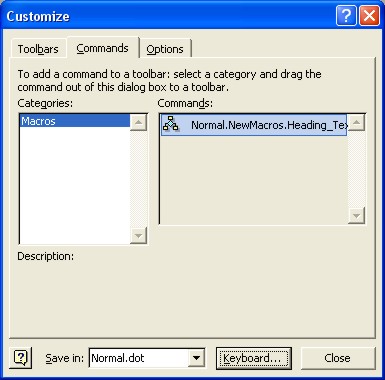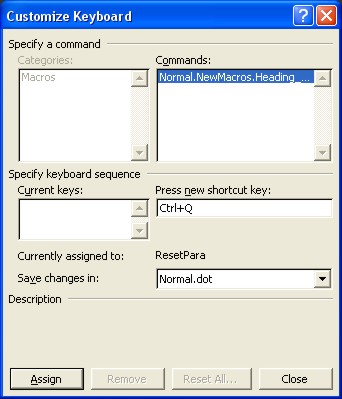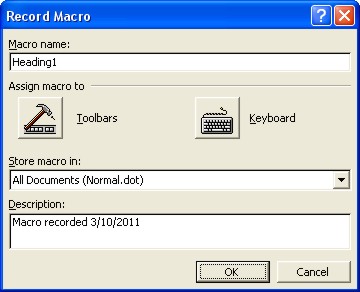
Word Macros
|
|
|
|
|
|
|
|
|
|
|
|
|
|
Word Macros
Additional Resources
Word Macros
Word Macros
Word Macros |
 |
If you perform a task repeatedly in Word, you can automate the task by using a macro.
A macro is a series of Word commands and instructions that you group together as a single command to accomplish a task automatically.
Some other uses for macros can include:
► Speeding up routine editing and formatting.
► Combining multiple commands - for example, inserting a table with a specific size and borders, and with a specific number of rows and columns.
► Making an option in a dialog box more accessible
► Automate a complex series of tasks.
No matter what you choose to do, Word macros can make your daily tasks much easier!
|
|
What's on this page... Create a Macro Assign a macro to a toolbar or menu Assign a macro to a shortcut key Run a Macro Edit a Macro Delete a Macro |
Create Word Macros
The macro recorder can help you get started creating Word macros. Word records a macro as a series of Word commands in Visual Basic for Applications. When you're recording a macro, you can temporarily pause recording and then resume recording where you stopped.When you record a macro, you can use the mouse to click commands and options, but the macro recorder doesn't record mouse movements in a document window. You must use the keyboard to record these actions.
|
|
Before you record or write a macro, first plan the steps and commands you want the macro to perform. If you make a mistake when you record the macro, corrections you make will also be recorded. You can edit the macro later and remove unnecessary steps you recorded. Try to anticipate any messages that Word might display that might halt your macro or be confusing when the macro is run. If you want to use the macro you're recording in other documents, make sure that the macro doesn't depend on the current document's contents. |
To create a macro by recording, follow these steps:
| 1. | Choose "Tools" ► "Macro" ► "Record
New Macro" from the menu bar. The Record Macro dialog box opens. |
||
|
|||
| 2. | In the "Macro Name" text box, type a name for
the macro which you are about to start recording. CAUTION: You can't use spaces, hyphens or any other character in the name, but you can use underscores and numbers as well. |
||
|
|||
| 3. | From the "Store Macro In" drop-down list, select the template or document in which you want to store the macro. | ||
| 4. | Type a description for your new macro in the "Description" text box. | ||
| 5. | If you don't want to assign the macro to a toolbar, a menu, or shortcut keys, click OK to begin recording the macro. | ||
|
To assign the macro to a
Toolbar or Menu: ► Click on the "Toolbars" button  ► Click the "Commands" tab if is not already selected. ► In the Commands list box, click-and-drag, the macro you are recording, to the toolbar or menu you want to assign it to. ► Once done, click "Close" to begin recording the macro. |
|||
|
To assign the macro to a
Shortcut Key: ► Click the "Keyboard" button at the bottom of the window.  ► In the "Commands" list box, click the macro you are recording. ► In the "Press new shortcut key" text box, type the key sequence. (Press the actual shortcut key combination that you want to use). ► Click "Assign". ► Click "Close" to begin recording the macro. |
|||
|
|||
| 6. | Start performing the actions you want to include in your macro. | ||
|
|||
| 7. | To stop recording your Word macros, click the "Stop Recording" button to stop the macro. | ||
|
|
|||
| Back to Top |
| See also... Run a Macro | Edit a Macro | Delete a Macro |
| Return to Microsoft Word XP from Word Macros |
Microsoft Word XP
Q & A
Antonyms
AutoCorrect
AutoShapes & Text Boxes
Bookmarks
Borders
Bullets
Change Case
ClipArt
Columns
Convert PDF to Word
Convert Word to HTML
Convert Word to PDF
Customize Menus
Customize Shortcut keys
Customize Toolbars
Delete a File
Delete Text
Download Borders
Download Fonts
Drop Cap
Envelopes
Find & Replace
Fonts
Footers
Format Painter
Headers
Highlight Text
Indent
Labels
Line Spacing
Macros
Mail Merge
Margins
Move or Copy
Numbering
Open a File
Outline Numbering
Page Numbers
Page Orientation
Page/Section Break
Password
PDF to Word Converter
Print Preview
Rename a File
Save a File
Screen Layout
Selecting Text
Special Characters
Spelling & Grammar
Styles
Symbols
Synonyms
Tables
Tabs
Text Wrap
Thesaurus
Undo
Word Counter
Word to HTML Converter
Word to PDF Converter
WordArt
Zoom
